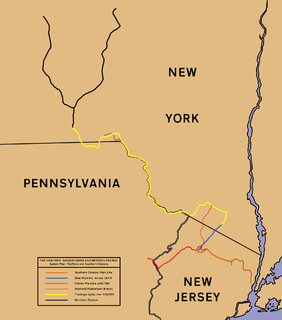
The New York, Susquehanna and Western Railway is a Class II American freight railway operating over 400 miles (645 km) of track in the northeastern U.S. states of New York, Pennsylvania, and New Jersey.

The Central New England Railway was a railroad from Hartford, Connecticut and Springfield, Massachusetts west across northern Connecticut and across the Hudson River on the Poughkeepsie Bridge to Maybrook, New York. It was part of the Poughkeepsie Bridge Route, an alliance between railroads for a passenger route from Washington to Boston, and was acquired by the New York, New Haven & Hartford Railroad in 1904.
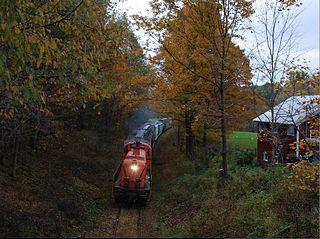
The Batten Kill Railroad is a class III railroad operating in New York. The BKRR was formed in 1982 beginning operations on October 22 of a pair of abandoned Delaware and Hudson Railway branch lines, totaling about 30 miles of track.

The Delaware and Hudson Railway (D&H) is a railroad that operates in the Northeastern United States. In 1991, after more than 150 years as an independent railroad, the D&H was purchased by the Canadian Pacific Railway (CP). CP operates D&H under its subsidiary Soo Line Corporation which also operates Soo Line Railroad.
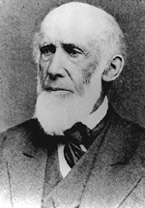
John Bloomfield Jervis was an American civil engineer. America's leading consulting engineer of the antebellum era (1820–60), Jervis designed and supervised the construction of five of America's earliest railroads, was chief engineer of three major canal projects, designed the famous, pioneering, DeWitt Clinton steam locomotive in 1831 while with the Mohawk & Hudson RR, designed the first locomotive with a swiveling 4-wheeled front bogie truck in 1832 for the M&H RR, designed and built the 41-mile Croton Aqueduct – New York City's fresh water supply from 1842 to 1891 – and was a consulting engineer for the Boston water system.

The Rensselaer and Saratoga Railroad was chartered on April 14, 1832. It completed 25.2 miles (40.6 km) between Troy and Ballston Spa on March 19, 1836.
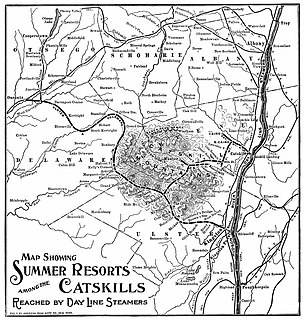
The Ulster and Delaware Railroad (U&D) was a railroad located in the state of New York. It was often advertised as "The Only All-Rail Route to the Catskill Mountains." At its greatest extent, the U&D extended 107 miles (172 km) from Kingston Point on the Hudson River through the Catskill Mountains to its western terminus at Oneonta, passing through the counties of Ulster, Delaware, Schoharie and Otsego.
New York State Route 173 (NY 173) is a state highway located in the Syracuse area of central New York in the United States. It takes a slightly bow-shaped route from NY 31 in the town of Van Buren to NY 5 in Chittenango, gently curving to the south of Downtown Syracuse in the center of its 30.59-mile (49.23 km) routing. Even so, NY 173 briefly enters the Syracuse city limits near where it intersects U.S. Route 11 (US 11). NY 173 passes through several suburbs of Syracuse, including Camillus, where it first meets NY 5, and Manlius, where it has a short overlap with NY 92.
New York State Route 29 (NY 29) is a state highway extending for 94.79 miles (152.55 km) across the eastern portion of the U.S. state of New York. The western terminus of the route is at NY 28 and NY 169 in Middleville, Herkimer County. The eastern terminus of the route is at NY 22 just south of Salem, Washington County. NY 29 also serves the cities of Johnstown and Saratoga Springs and intersects four major north–south roadways: NY 10, NY 30, U.S. Route 9, and U.S. Route 4.

The Adirondack Railway was a railroad that connected Saratoga Springs to North Creek, New York, a distance of 62 miles (100 km). Built by Dr. Thomas Clark Durant, vice-president of the Union Pacific Railroad, it was started in 1864 and completed in 1871. After Durant's death, it was taken over by his son, William West Durant, who sold it to the Delaware and Hudson Canal Company in 1889. The two companies officially merged on November 5, 1902. A stage-coach line was established to take passengers 28 miles (45 km) to Durant properties at Blue Mountain Lake and further by water to Raquette Lake.
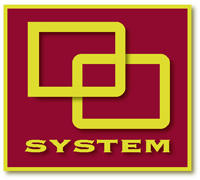
The Delaware Otsego Corporation (DO) is an American railway holding company which owns the New York, Susquehanna and Western Railway and the Central New York Railroad. It is headquartered in Cooperstown, New York in Otsego County.

A predecessor to the Class I Delaware and Hudson Railway, the 1820s-built Delaware and Hudson Canal Company Gravity Railroad('D&H Gravity Railroad') was a historic gravity railroad incorporated and chartered in 1826 with land grant rights in the US state of Pennsylvania as a humble subsidiary of the Delaware and Hudson Canal and it proved to contain the first trackage of the later organized Delaware and Hudson Railroad. It began as the second long U.S. gravity railroad built initially to haul coal to canal boats, was the second railway chartered in the United States after the Mohawk and Hudson Rail Road before even, the Baltimore and Ohio. As a long gravity railway, only the Summit Hill and Mauch Chunk Railroad pre-dated its beginning of operations.
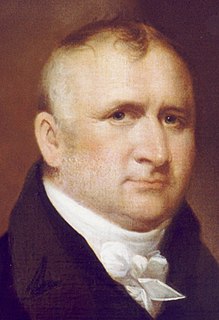
Benjamin Wright was an American civil engineer who was chief engineer of the Erie Canal and the Chesapeake and Ohio Canal. In 1969, the American Society of Civil Engineers declared him the "Father of American Civil Engineering".
The Ogdensburg and Lake Champlain Railroad was founded in 1849 as the Northern Railroad running from Ogdensburg to Rouses Point, New York. The 118-mile (190 km) railroad was leased by rival Central Vermont Railroad for several decades, ending in 1896. It was purchased in 1901 by the Rutland Railroad and became its Ogdensburg Division.

The Batten Kill, Battenkill, or Battenkill River is a 59.4-mile-long (95.6 km) river rising in Vermont that flows into New York and is a tributary of the Hudson River. It is the longest Hudson tributary on that river's east. As "kill" means a creek, the name "Battenkill River" is pleonastic.

Greenwich is a town in the southwestern part of Washington County, New York, United States. The town is located on the western border of the county. The population was 4,896 at the 2000 census. It is part of the Glens Falls Metropolitan Statistical Area. Greenwich features several homes that were a part of the Underground Railroad.
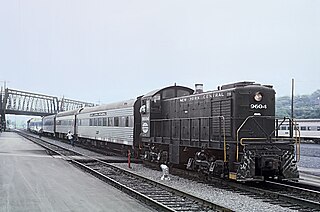
The Laurentian was a named passenger train operated by the Delaware and Hudson Railway between New York City and Montreal, providing same-day daylight service. The train used the D&H's famed route along Lake Champlain north of Albany, New York. The Laurentian, along with its overnight companion the Montreal Limited, was the flagship of the D&H from its inauguration in 1923 until its discontinuance on April 30, 1971. Since 1974, Amtrak has operated the Adirondack over the same route.
The Adirondack Railway was a short-lived tourist railroad which operated in northeastern New York. The company was founded in 1976 to operate a disused railway line owned by New York State since 1974. It operated trains between 1979–1981, including from Utica to Lake Placid, New York, for the 1980 Winter Olympics, before multiple derailments led to the end of service. The route is now operated by the Adirondack Railroad from Utica to Thendara and Big Moose, New York, which will extend service to Tupper Lake by 2022 after New York State completes track renovation northeast from Big Moose: scheduled for November, 2021.
The Saratoga and Washington Railroad was an early railroad in the state of New York. It was chartered in 1834, opened for operation in 1848, and reorganized as the Saratoga and Whitehall Railroad in 1855. Its tracks eventually became part of the Delaware and Hudson Company.

United States gubernatorial elections were held in 1891, in seven states.















